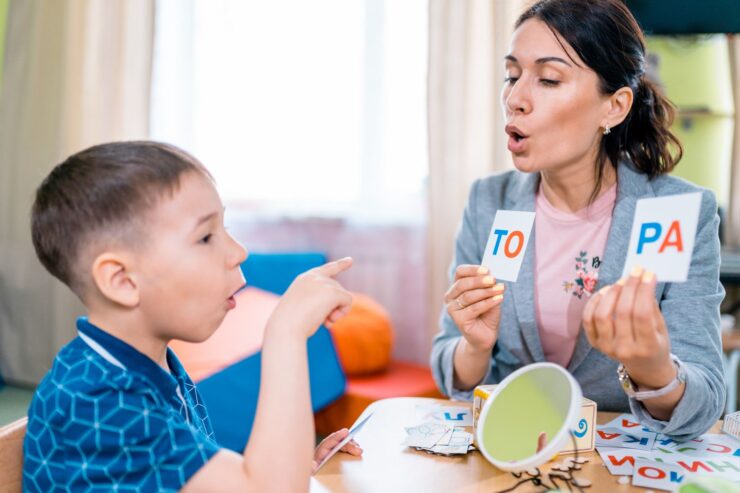If your child struggles to speak their mind or understand what others are saying they might not be alone. Children sometimes suffer from developmental delays, speech impediments, or communication disorders that can significantly impact the quality of their lives.
You can help your child overcome communication barriers and achieve their full potential by consulting a speech-language pathologist for timely support and therapy. Think of early identification and treatment as giving your child a strong foundation for communication. By addressing any issues early on, you’re helping them build the skills they need to succeed in school and throughout their lives.
Early intervention in speech-language pathology (SLP) refers to proactively identifying and addressing communication disorders in children at a young age. It involves promptly detecting and treating speech and language issues to support a child’s communication skills and overall development.
Continue reading this article to explore further early intervention strategies to address challenges early on, preventing potential long-term academic, social, and emotional consequences.
Early Identification of Communication Disorders
Identifying communication issues early on can set the stage for timely intervention.
Screening Methods

Early screening is crucial for spotting communication delays in infants and toddlers. Methods like standardized tests, parent surveys, and observing interactions with caregivers help evaluate speech and language development. These assessments are vital for timely intervention and support in addressing communication disorders during early childhood.
The widespread use of screening instruments like the Age and Stages Questionnaires (ASQ) and the Communication and Symbolic Behavior Scales (CSBS) is emphasized by online SLP courses, like Ithaca College’s Master’s program, to identify possible delays and disorders in communication abilities.
Risk Factors and Red Flags
Certain risk factors, like family history of communication issues, premature birth, low birth weight, chronic ear infections, exposure to toxins like lead, and developmental delays, may suggest speech and language challenges in kids. Identifying these factors can aid in timely intervention and support for better outcomes in children’s development.
Understanding sensory processing disorder in children is also crucial, as sensory issues can often coexist with speech difficulties, affecting their ability to communicate effectively.
Red flags are the tell-tale signs of speech difficulties. They may include limited babbling or vocalizations, lack of response to sounds or names, difficulty understanding or following instructions, limited vocabulary development, and persistent speech sound errors beyond expected developmental stages.
Identifying these risk factors and red flags early on enables healthcare professionals, educators, and caregivers to initiate timely intervention and support services, promoting optimal communication and development in children.
How Early Intervention Helps

Timely prophylactic strategies can have drastic long-term outcomes and mitigate the impact of communication disorders on your child’s overall growth and quality of life. Kids who receive targeted therapy sooner improve developmental outcomes across various domains. It helps enhance speech, language, and communication skills, improving academic achievement, social interactions, and overall quality of life.
Studies also indicate that such children show marked improvement in language proficiency, communication aptitude, and cognitive abilities. These contribute to better academic performance and school readiness, as children are better equipped to participate in classroom activities and engage with peers.
Additionally, early support nurtures vital social skills like peer interaction, cooperation, and emotional regulation. This assists kids in building positive relationships, handling social situations well, and encountering fewer behavioral hurdles.
Swift intervention sets the foundation for long-term success by equipping children with the necessary skills and support to thrive academically, socially, and emotionally, enhancing their overall quality of life.
Adopting a Multidisciplinary Approach
Helping kids with communication disorders involves teamwork. Speech therapists, pediatrician doctors, teachers, and specialists work together, each bringing their skills to the table. This collaboration ensures thorough evaluation, tailored treatment, and ongoing support for children with communication disorders.
Speech-language therapists and pediatricians work together to comprehensively assess the child’s needs, covering speech, language, and other developmental and educational areas. They monitor the child’s progress and coordinate personalized medical care.
Educators play a crucial role in implementing intervention strategies and supporting academic progress. This collaborative approach ensures holistic support for your child’s development across medical and educational domains.
Family involvement and caregiver training are essential components of early intervention. Engaging families empowers them to support their child’s communication development.
Caregivers can learn strategies for facilitating language growth, promoting communication at home, and integrating therapeutic activities into daily routines. This can ultimately maximize the effect of therapy and encourage long-term success for children with communication disorders.
Evidence-Based Intervention Strategies

Practical strategies for helping children with common communication issues in early childhood involve practical approaches like modeling proper language use, engaging in interactive activities, and incorporating structured play and reading sessions. For language delays, activities like storybook reading and language-rich interactions are beneficial.
If your child has an articulation disorder, interventions focusing on speech sound production through various exercises and drills such as auditory discrimination, phonological awareness training, and targeting speech drills can be helpful.
It is crucial to tailor interventions to each child’s unique needs and stage of development by conducting thorough assessments. This will help you identify specific difficulty areas and design interventions that address those needs.
Additionally, interventions should consider the child’s interests, strengths, and learning style to maximize engagement and progress. Regular monitoring and adjustment to the intervention plan ensure ongoing effectiveness and progress toward communication goals.
Future Directions

Innovation in intervention techniques and technology holds promise for improving therapy outcomes. Advancements in early intervention encompass screening, assessment, intervention techniques, and technology.
Future developments aim to refine screening tools and introduce more sensitive measures, aided by artificial intelligence and machine learning algorithms, for enhanced accuracy and efficiency of the screening process.
Integrating genetic testing and neuroimaging may offer insights into disorder causes and facilitate personalized intervention approaches. Innovative techniques like virtual and augmented reality can offer immersive and interactive environments for therapy, enhancing engagement and motivation.
Telepractice, including video conferencing and mobile applications, allows for remote delivery of services, increasing access to intervention for underserved populations.
Advances in assistive technology, such as wearable devices and speech-generating devices, offer new avenues for supporting communication development and independence in individuals with severe communication disorders. These advancements can potentially transform the landscape of support for children.
Endnote
Identifying and treating communication disorders timely can significantly impact your child’s school performance, make forming friendships easier, and lead a much happier life. You must prioritize promptly identifying and treating these communication disorders because they can significantly impact the child’s future performance.
Follow the strategies discussed in this article to break down barriers to communication development in early childhood and support kids in conquering communication challenges early on, ensuring that every child can reach their full potential and thrive and excel in all areas of life.







